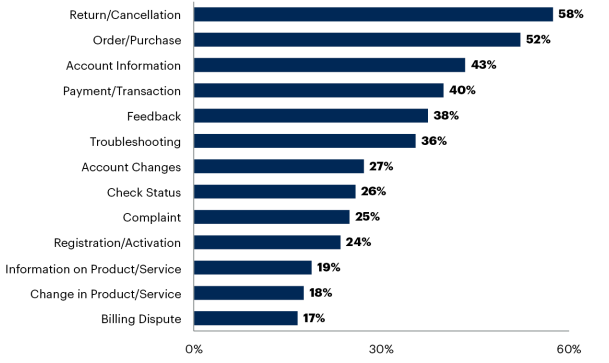Amidst the constantly advancing technology landscape, chatbots have become a widely adopted solution for businesses to address customer issues and inquiries. Yet, despite their growing prominence, a recent survey conducted by Gartner, Inc. revealed that only 8% of customers actually used a chatbot during their most recent customer service interaction. What’s even more concerning is that only a quarter of those customers expressed their willingness to use chatbots again in the future.
This raises the question of why customers are reluctant to embrace chatbots, which seem like a more convenient alternative to connecting with customer service and support.
Despite the growing emphasis that customer service and support leaders are placing on AI-based chatbots, it’s intriguing to observe that customers have not fully embraced this technology. The low adoption rate suggests that chatbots may not consistently deliver the desired outcomes for customers. It leads us to another important question: are chatbots truly fulfilling their intended purpose and effectively assisting customers?
The disparity between expectations and reality prompts a deeper exploration into the effectiveness and limitations of chatbot technology in customer service and support.
Chatbots Adoption Remains Low
In a comprehensive survey carried out by Gartner from December 2022 to February 2023, a total of 497 B2B and B2C customers participated. The findings of this survey shed light on a crucial aspect of chatbot adoption.
Interestingly, the key factor influencing chatbot adoption is its ability to effectively solve customer issues. This aspect alone accounted for a significant 18% of the variation in customers’ likelihood to use chatbots again.
To put it simply, if a chatbot is successful in solving a customer’s problem, it significantly increases the chances of customers using it again. This emphasizes the importance of chatbots being proficient problem-solvers to gain customer trust and encourage continued usage.
However, the above data shows that despite the advancements in chatbot technology, there remains a gap between what customers expect and what chatbots are currently able to deliver.
Michael Rendelman, a Senior Specialist in Gartner’s Customer Service and Support practice, emphasized the need for improvement in chatbot adoption, stating, “While many customer service and support leaders look to chatbots as the future of the function, customers clearly need some convincing. To improve chatbot adoption, the key is to focus on improving the chatbot’s ability to move customers’ issues forward.”
Resolution Rates by Service Issue Type for Chatbot Users
The Gartner survey brought to light an intriguing finding regarding chatbot resolution rates for different types of customer issues. Surprisingly, chatbots demonstrated a commendable 58% success rate in resolving returns and cancellations. This data is noteworthy, considering that resolving returns and cancellations can be complex tasks sometimes, often involving specific details, order information, and customer preferences. Traditionally, such matters might require human intervention to handle effectively. However, chatbots, powered by advanced artificial intelligence, demonstrated their capability to tackle these challenges and achieve a commendable success rate.
Further analysis of the survey results unveiled additional resolution rates for various types of customer issues. Chatbots demonstrated a 52% success rate in resolving order and purchase-related queries, followed by 43% for account information and 40% for payment and transactions.
However, when it came to billing disputes, the chatbot’s resolution rate dropped greatly to a mere 17%. This decline can be attributed to the nature of billing disputes, which often necessitate direct communication with customer support representatives. The complexity and nuanced nature of these disputes makes them less conducive to resolution through chatbots alone.
The survey uncovered an interesting disparity between the perception of service organizations and customers regarding chatbot capabilities. While service organizations have a thorough understanding of the strengths and limitations of their chatbots, as well as which issues are well-suited for chatbot resolution, customers lack the same level of awareness.
The survey revealed that customers showed only a marginal 2% higher likelihood to use a chatbot for a return/cancellation compared to a billing dispute, despite the notable difference in resolution rates between the two. This suggests that customers may not fully grasp the specific areas where chatbots excel or the optimal use cases for chatbot assistance.

Companies should take note of the discrepancies in resolution rates and invest in further improving chatbot capabilities, particularly in addressing billing disputes, to ensure consistent and satisfactory outcomes. By enhancing chatbot performance across all customer issues, businesses can instil greater trust and encourage wider adoption of chatbot technology.
Michael Rendelman, a Senior Specialist in Gartner’s Customer Service and Support practice, highlights that chatbots may not be effective in resolving all types of customer issues. As generative AI continues to advance and make chatbots more sophisticated, there is a risk of increasing customer confusion regarding the capabilities and limitations of chatbots.
In light of this, it becomes the responsibility of service and support leaders to provide clear guidance to customers, directing them towards chatbots when it is suitable for their specific issue and steering them towards alternative channels when another channel would be more appropriate.
It is crucial for companies to invest in refining chatbot capabilities, ensuring they are intuitive, efficient, and capable of providing personalized and seamless experiences. Only through tangible and convincing results AI-powered chatbots can gain the trust and acceptance of customers as the future of customer service.
As businesses navigate the evolving landscape of customer service, one question remains; How can organizations bridge the gap between customer expectations and the actual capabilities of chatbots to fully leverage their potential and deliver exceptional customer experiences? And, how do you envision the future of chatbots in the tech era as technology advances over the next decade? Perhaps, there is a lot more to dig deep into the matter. And, we will.
What do you think about the future of chatbots? Do let us know your views in comment section below.

